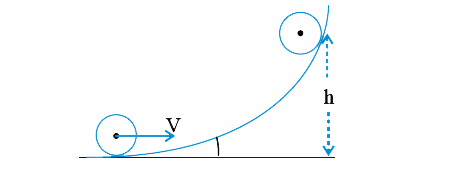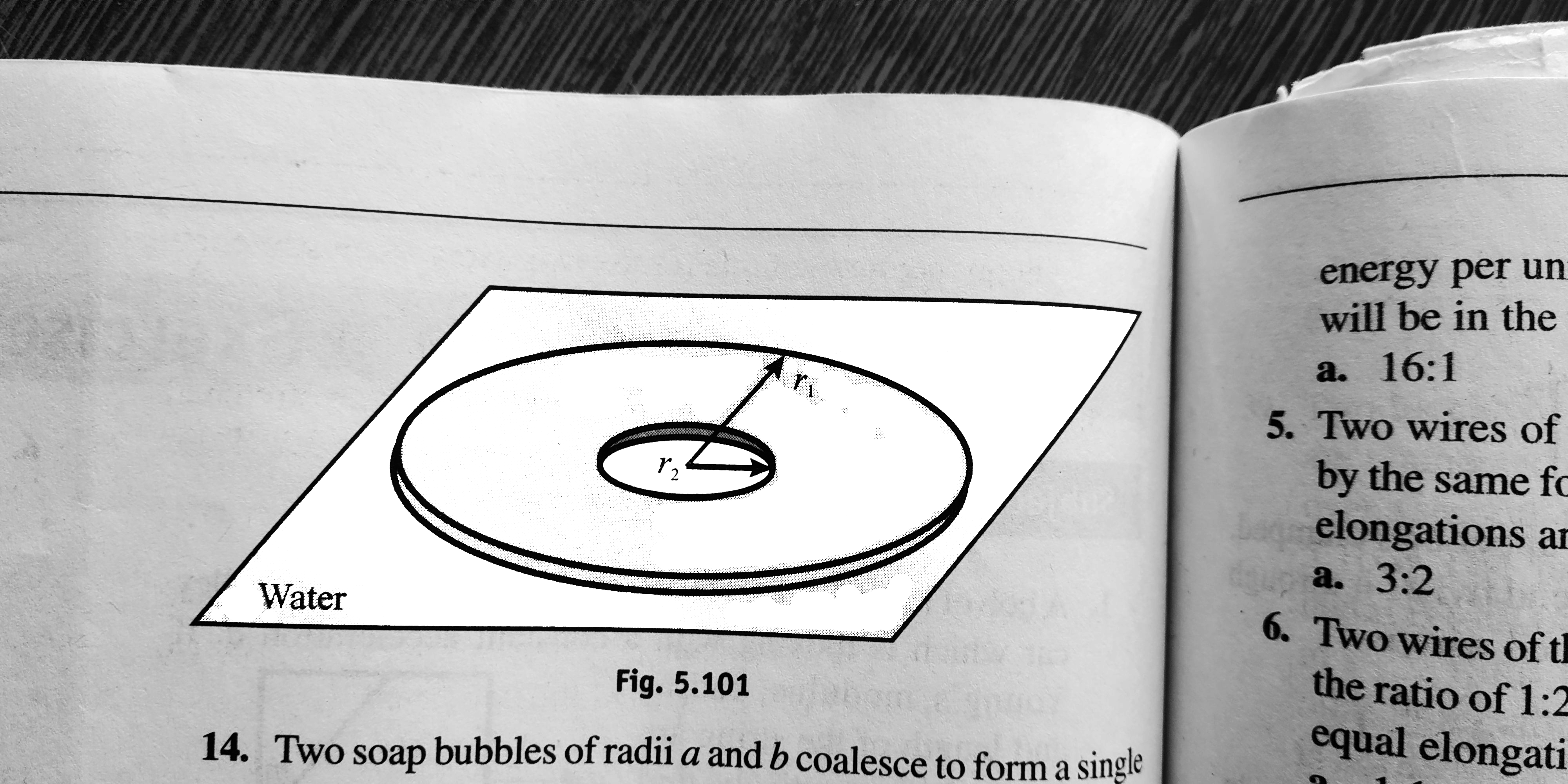A thin metal disc of radius r floats on water surface and bends the surface downwards along the perimeter making an angle θ with vertical edge of the disc . If the disc displaces a weight of water W and surface tension of water is T, then the weight of metal disc is
2πrT=W
2πrTcosθ−W
2πrTcosθ+W
W−2πrTcosθ
The correct Answer is:C
To solve the problem, we need to analyze the forces acting on the thin metal disc floating on the water surface. The disc bends the surface of the water and makes an angle θ with the vertical. We will use the principles of buoyancy and surface tension to find the weight of the metal disc.
1. Identify Forces Acting on the Disc:
- The forces acting on the disc include:
- The buoyant force (FB) acting upwards.
- The surface tension force (T) acting along the perimeter of the disc, which has both vertical and horizontal components.
2. Calculate the Surface Tension Force:
- The surface tension force acts along the circumference of the disc. The total length of the perimeter (L) of the disc is given by:
L=2πr
- The vertical component of the surface tension force (acting upwards) can be calculated as:
FT=2Tcos(θ)
- Here, 2T is the total surface tension acting along the perimeter, and cos(θ) gives the vertical component.
3. Apply Archimedes' Principle:
- According to Archimedes' principle, the buoyant force (FB) is equal to the weight of the water displaced by the disc. This is given as:
FB=W
- Where W is the weight of the water displaced.
4. Set Up the Equilibrium Condition:
- At equilibrium, the total upward forces must balance the weight of the disc (mg). Therefore, we can write:
mg=FB+FT
- Substituting the expressions for FB and FT:
mg=W+2Tcos(θ)
5. Rearranging to Find the Weight of the Disc:
- Rearranging the equation gives us the weight of the metal disc:
mg=W+2Tcos(θ)
- Thus, the weight of the metal disc is:
mg=W+2Tcos(θ)
Final Result:
The weight of the metal disc is given by:
Weight of the disc=W+2Tcos(θ)
- The forces acting on the disc include:
- The buoyant force (FB) acting upwards.
- The surface tension force (T) acting along the perimeter of the disc, which has both vertical and horizontal components.
- The surface tension force acts along the circumference of the disc. The total length of the perimeter (L) of the disc is given by:
L=2πr
- The vertical component of the surface tension force (acting upwards) can be calculated as:
FT=2Tcos(θ)
- Here, 2T is the total surface tension acting along the perimeter, and cos(θ) gives the vertical component.
- According to Archimedes' principle, the buoyant force (FB) is equal to the weight of the water displaced by the disc. This is given as:
FB=W
- Where W is the weight of the water displaced.
- At equilibrium, the total upward forces must balance the weight of the disc (mg). Therefore, we can write:
mg=FB+FT
- Substituting the expressions for FB and FT:
mg=W+2Tcos(θ)
- Rearranging the equation gives us the weight of the metal disc:
mg=W+2Tcos(θ)
- Thus, the weight of the metal disc is:
mg=W+2Tcos(θ)
The weight of the metal disc is given by:
Weight of the disc=W+2Tcos(θ)
Topper's Solved these Questions
- FLUID MECHANICSBOOK - DC PANDEY ENGLISHCHAPTER - FLUID MECHANICSEXERCISE - Level 2 More Than One Correct
10 Videos
- FLUID MECHANICSBOOK - DC PANDEY ENGLISHCHAPTER - FLUID MECHANICSEXERCISE - Level 2 Comprehension Based
7 Videos
- FLUID MECHANICSBOOK - DC PANDEY ENGLISHCHAPTER - FLUID MECHANICSEXERCISE - Subjective Question
2 Videos
- EXPERIMENTSBOOK - DC PANDEY ENGLISHCHAPTER - EXPERIMENTSEXERCISE - Subjective
15 Videos
- GENERAL PHYSICSBOOK - DC PANDEY ENGLISHCHAPTER - GENERAL PHYSICSEXERCISE - INTEGER_TYPE
2 Videos
Similar Questions
In a capillary tube of radius 'R' a straight thin metal wire of radius 'r' (R>r) is inserted symmetrically and one of the combination is dipped vertically in water such that the lower end of the combination Is at same level . The rise of water in the capillary tube is [T=surface tensiono of water ρ =density of water ,g =gravitational acceleration ]
View SolutionThe length of a needle floating on water is 2.5cm. The minimum force in addition to its weight needed to lift the needle above the surface of water will be (surface tension of water is 0.072N/m)
View SolutionThe length of needle foating on the surface of water is 1.5 cm the force in addition to its weight required to lift the needle from water surface will be (surface tension of water =7.5N/cm)
View SolutionA disc of mass M and radius R rolls on a horizontal surface and then rolls up an inclined plane as shown in the figure. If the velocity of the disc is v, the height to which the disc will rise will be:

View SolutionAn annular disc of radius r1=10cm and r2=5cm is placed on a water surface. Find the surface tension force on the disc if we want to pull it from water surface. Take coefficient of surface tension as σ=72dy≠/cm,g=10ms−2.

View SolutionA paper disc of radius R from which a hole of radius r is cut out is floating in a liquid of the surface tension S. The force on the disc due to the surface tension is
View SolutionA uniform disc of mass 'm' and radius R is placed on a smooth horizontal floor such that the plane surface of the disc in contact with the floor . A man of mass m/2 stands on the disc at its periphery . The man starts walking along the periphery of the disc. The size of the man is negligible as compared to the size of the disc. Then the center of disc.

View SolutionA thin disc of radius R has charge Q distributed uniformly on its surface. The disc is rotated about one of its diametric axis with angular velocity ω. The magnetic moment of the arrangement is
View SolutionA uniform disc is acted by two equal forces of magnitude F. One of them, acts tangentially to the disc, while other one is acting at the central point of the disc. The friction between disc surface and ground surface in nF. If r be the radius of the disc, then the value of n would be (in N)
View SolutionA mosquito with 8 legs stands on water surface and each leg makes depression of radius 'a'. If the surface tension and angle of contact are 'T' and zero respectively, then the weight of mosquito is:
View Solution
